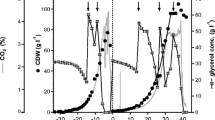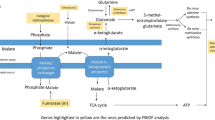Abstract.
A fusion protein composed of a cellulose binding domain from Neocallimastix patriciarum cellulase A and Candida antarctica lipase B (CBD-lipase) was produced by Pichia pastoris methanol utilization plus phenotype in high cell-density cultures. The genes expressing CBD-lipase were fused to the alpha-factor secretion signal sequence of Saccharomyces cerevisiae and placed under the control of the alcohol oxidase gene (AOX1) promoter. To control the repression and induction of AOX1 and oxygen demand at high cell density, a four-stage process was used. Batch growth on glycerol was used in the first step to provide biomass (28 g L–1) while product formation was prevented due to repression of the AOX1. The second stage was exponential fed-batch growth on glycerol, which caused a slight increase of the enzyme alcohol oxidase activity due to derepression of the AOX1. This procedure resulted in smooth transition to exponential fed-batch growth on methanol, the third stage, in which the AOX1 was strongly induced. The fourth stage was constant fed-batch growth on methanol used to control the oxygen demand at the high cell density. A kinetic model was developed that could predict biomass growth and oxygen consumption in processes with and without oxygen-enriched air. With oxygen enrichment to 34% O2 in the inlet air the methanol feed rate could be increased by 50% and this resulted in 14% higher final cell density (from 140 to 160 g L–1 cell dry weight). The increased methanol feed rate resulted in a proportionally increased specific rate of product secretion to the medium. After an initial decrease, the synthesis capacity of the cell was kept constant throughout the cultivation, which made the product concentration increase almost constantly during the process. The kinetic model also describes how the low maintenance demand of P. pastoris compared with E. coli enables this organism to grow to such high cell densities.
Similar content being viewed by others
Author information
Authors and Affiliations
Additional information
Electronic Publication
Rights and permissions
About this article
Cite this article
Jahic, .M., Rotticci-Mulder, .J., Martinelle, .M. et al. Modeling of growth and energy metabolism of Pichia pastoris producing a fusion protein. Bioprocess Biosyst Eng 24, 385–393 (2002). https://doi.org/10.1007/s00449-001-0274-5
Received:
Accepted:
Issue Date:
DOI: https://doi.org/10.1007/s00449-001-0274-5




